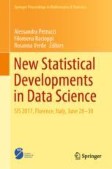Search
Search Results
-
A weighted distance metric for assessing ranking dissimilarity and inter-group heterogeneity
In this paper, a weighted variant of the normalized pairwise angular distance metric is proposed. The inclusion of position weights aims at...

-

-
A k-means method for trends of time series
A k -means method style clustering algorithm is proposed for trends of multivariate time series. The usual k -means method is based on distances or...

-
Entropy-based fuzzy clustering of interval-valued time series
This paper proposes a fuzzy C -medoids-based clustering method with entropy regularization to solve the issue of grou** complex data as...

-
Fuzzy clustering of time series based on weighted conditional higher moments
This paper proposes a new approach to fuzzy clustering of time series based on the dissimilarity among conditional higher moments. A system of...

-
Nomclust 2.0: an R package for hierarchical clustering of objects characterized by nominal variables
In this paper, we present the second generation of the nomclust R package, which we developed for the hierarchical clustering of data containing...

-
Logistic regression models for elastic shape of curves based on tangent representations
Shape analysis is widely used in many application areas such as computer vision, medical and biological studies. One challenge to analyze the shape...

-
Two Simple but Efficient Algorithms to Recognize Robinson Dissimilarities
A dissimilarity d on a set S of size n is said to be Robinson if its matrix can be symmetrically permuted so that its elements do not decrease when...

-
Three-Way Symbolic Tree-Maps and Ultrametrics
Three-way dissimilarities are a generalization of (two-way) dissimilarities which can be used to indicate the lack of homogeneity or resemblance...
-
Similarity-Reduced Diversities: the Effective Entropy and the Reduced Entropy
The paper presents and analyzes the properties of a new diversity index, the effective entropy, which lowers Shannon entropy by taking into account...

-
A Three-Way Data Analysis Approach for Analyzing Multiplex Networks
In the present contribution, the use of factorial methods for three-way data is proposed to visually explore the structure of multiplex networks,...
-
A clustering procedure for mixed-type data to explore ego network typologies: an application to elderly people living alone in Italy
The analysis of ego networks has attracted a great attention recently and found application in many areas of the social sciences. In particular, the...

-
Triplet Clustering of One-Mode Two-Way Proximities
Some researchers noticed that proximities of three objects are useful to disclose relationships among objects. Sometimes it is not easy to obtain...
-
Distance Measurement When Fuzzy Numbers Are Used. Survey of Selected Problems and Procedures
The goal is to identify and to discuss distance and dissimilarity measures calculated with fuzzy numbers. It is crucial to define the distance and...
-
Additive Trees for Fitting Three-Way (Multiple Source) Proximity Data
Additive trees are graph-theoretic models that can be used for constructing network representations of pairwise proximity data observed on a set of N...
-
Liszt’s Étude S.136 no.1: audio data analysis of two different piano recordings
In this paper, we review the main signal processing tools of Music Information Retrieval (MIR) from audio data, and we apply them to two recordings...

-
Wavelet Multidimensional Scaling Analysis of European Economic Sentiment Indicators
We propose the use of wavelet coefficients, which are generated from nondecimated discreet wavelet transforms, to form a correlation-based...

-
Comparing Mankiewicz and Welles to the Citizen Kane Screenplay (1): Relative Frequencies, Distinctiveness Ratios, and Confidence Intervals
This chapter employs Mankiewicz’s and Welles’s statistical profiles to assign authorship in a precise way to the Citizen Kane screenplay. The...
-
Evaluating the Quality of Data Imputation in Cardiovascular Risk Studies Through the Dissimilarity Profile Analysis
Missing data handling is one of the crucial problems in statistical analyses, and almost always is overcome by imputation. Although the literature is...
-
Cluster Analysis
A cluster analysis is used to identify groups of objects that are “similar”. This chapter explains the general procedure for determining clusters of...
